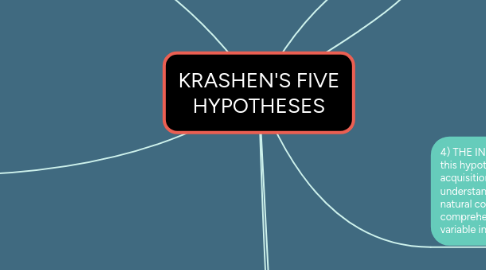
1. 1) THE ACQUISITION/LEARNING HYPOTHESIS: Krashen asserts that there is a distinct difference between acquiring and learning a second language.
1.1. Krashen defined acquisition as a natural process that occurs when the target language is used in meaningful interactions with native speakers; he believes the focus is communication and not accuracy of form.On the contrary, language learning, refers to the formal and conscious study of language forms and functions as explicitly taught in foreign language classrooms.
1.2. Krashen claims two things: 1) that learning cannot turn into acquisition; 2) that it is only acquired language that is available for natural, fluent communication. His critics however, pointed out that it would be extremely difficult, if not impossible, to detect whether, acquisition or learning, is at work in any instance of language use.
1.2.1. Thus, concluding that it is impossible to distinguish acquisition from learning, and much less prove, that "learned language" cannot become "acquired language."
2. Stephen Krashen was a seminal researcher in the innatist tradition. He developed a series of hypotheses about second language acquisition that took root in the field of second language teaching due to their relevance to language education.
3. 2) THE MONITOR HYPOTHESIS: Krashen proposes that formal study of language, leads to development of an internal grammar editor or monitor. (Example: as students produce sentences, a monitor examines the output, to make sure the correct usage is being implemented).
3.1. In order for the student to use the monitor, three conditions are put forth: sufficient time, focus on grammatical form, and explicit knowledge of rules; making it easier to use the monitor for writing rather than speaking. Krashen believes, that by knowing the rules, it helps learners polish their language.
3.2. He recommends the focus of language teaching to be on communication, rather than on just rule learning; this places him in agreement with a lot of second language acquisition and foreign language teaching experts.
3.2.1. As usual, Krashen has many critics to this hypothesis, and some researchers show that despite impressive language gains, some grammatical forms may not fully develop without explicit instruction.
4. In conclusion, Krashen summarizes his five hypothesis under one claim: "People acquire second language when they obtain comprehensible input and when their affective filters are low enough to allow the input in."
5. 3) THE NATURAL ORDER HYPOTHESIS: according to this hypothesis, language learners acquire (instead of learning) the rules of a language in a predictable sequence.
5.1. What this hypothesis is trying to say, is that certain grammatical features, or morphemes, tend to be acquired early, where others, tend to be acquired late. There is a considerable number of studies that support the general existence of natural order of acquisition of English grammatical features, both by child and adults.
6. 4) THE INPUT HYPOTHESIS: according to this hypothesis, second language acquisition is the direct result of learners' understanding the target language in natural communication situations. Meaning, comprehensible input is the causative variable in language acquisition.
6.1. Krashen has three constraints that define input: 1) it must be understandable (hint the term, comprehensible input:. 2) it must contain grammatical structures that are just a bit beyond the acquirer's current linguistic knowledge. 3) it must be a part of naturally flowing language used for authentic, purposeful communication.
6.1.1. Krashen believes that acquirers are able to understand this challenging level of input by using context, background knowledge, and non-linguistic cues (pictures and gestures).
6.2. Like other of his hypothesis, this one has been criticized and challenged as well. The basis for this challenge is based on two grounds.
6.2.1. First, the focus on comprehensible input ignores completely the role of the output, in this case being speaking and writing, in second language acquisition.
6.2.2. Secondly, there is no way to measure I+1, which is known as the ideal level of linguistic challenge for promoting acquisition.
